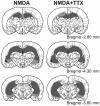Suppression of neurotoxic lesion-induced seizure activity: evidence for a permanent role for the hippocampus in contextual memory
- PMID: 22110648
- PMCID: PMC3215748
- DOI: 10.1371/journal.pone.0027426
Suppression of neurotoxic lesion-induced seizure activity: evidence for a permanent role for the hippocampus in contextual memory
Abstract
Damage to the hippocampus (HPC) using the excitotoxin N-methyl-D-aspartate (NMDA) can cause retrograde amnesia for contextual fear memory. This amnesia is typically attributed to loss of cells in the HPC. However, NMDA is also known to cause intense neuronal discharge (seizure activity) during the hours that follow its injection. These seizures may have detrimental effects on retrieval of memories. Here we evaluate the possibility that retrograde amnesia is due to NMDA-induced seizure activity or cell damage per se. To assess the effects of NMDA induced activity on contextual memory, we developed a lesion technique that utilizes the neurotoxic effects of NMDA while at the same time suppressing possible associated seizure activity. NMDA and tetrodotoxin (TTX), a sodium channel blocker, are simultaneously infused into the rat HPC, resulting in extensive bilateral damage to the HPC. TTX, co-infused with NMDA, suppresses propagation of seizure activity. Rats received pairings of a novel context with foot shock, after which they received NMDA-induced, TTX+NMDA-induced, or no damage to the HPC at a recent (24 hours) or remote (5 weeks) time point. After recovery, the rats were placed into the shock context and freezing was scored as an index of fear memory. Rats with an intact HPC exhibited robust memory for the aversive context at both time points, whereas rats that received NMDA or NMDA+TTX lesions showed a significant reduction in learned fear of equal magnitude at both the recent and remote time points. Therefore, it is unlikely that observed retrograde amnesia in contextual fear conditioning are due to disruption of non-HPC networks by propagated seizure activity. Moreover, the memory deficit observed at both time points offers additional evidence supporting the proposition that the HPC has a continuing role in maintaining contextual memories.
Conflict of interest statement
Figures


 ). (B) Mean ± SEM lesion extent calculated for each lesion group at the Recent and Remote intervals. All lesion groups sustained equivalent HPC damage.
). (B) Mean ± SEM lesion extent calculated for each lesion group at the Recent and Remote intervals. All lesion groups sustained equivalent HPC damage.
Similar articles
-
Neither time nor number of context-shock pairings affect long-term dependence of memory on hippocampus.Neurobiol Learn Mem. 2013 Nov;106:309-15. doi: 10.1016/j.nlm.2013.05.008. Epub 2013 Jun 7. Neurobiol Learn Mem. 2013. PMID: 23747567
-
Complete or partial hippocampal damage produces equivalent retrograde amnesia for remote contextual fear memories.Eur J Neurosci. 2007 Mar;25(5):1278-86. doi: 10.1111/j.1460-9568.2007.05374.x. Epub 2007 Mar 9. Eur J Neurosci. 2007. PMID: 17355254
-
Absence of systems consolidation of fear memories after dorsal, ventral, or complete hippocampal damage.Hippocampus. 2008;18(7):710-8. doi: 10.1002/hipo.20431. Hippocampus. 2008. PMID: 18446823
-
Retrograde amnesia after hippocampal damage: recent vs. remote memories in two tasks.Hippocampus. 2001;11(1):27-42. doi: 10.1002/1098-1063(2001)11:1<27::AID-HIPO1017>3.0.CO;2-4. Hippocampus. 2001. PMID: 11261770 Review.
-
New views on old memories: re-evaluating the role of the hippocampal complex.Behav Brain Res. 2001 Dec 14;127(1-2):183-97. doi: 10.1016/s0166-4328(01)00363-1. Behav Brain Res. 2001. PMID: 11718891 Review.
Cited by
-
The impact of multiple memory formation on dendritic complexity in the hippocampus and anterior cingulate cortex assessed at recent and remote time points.Front Behav Neurosci. 2014 Apr 21;8:128. doi: 10.3389/fnbeh.2014.00128. eCollection 2014. Front Behav Neurosci. 2014. PMID: 24795581 Free PMC article.
-
Relative contributions of CA3 and medial entorhinal cortex to memory in rats.Front Behav Neurosci. 2014 Aug 28;8:292. doi: 10.3389/fnbeh.2014.00292. eCollection 2014. Front Behav Neurosci. 2014. PMID: 25221487 Free PMC article.
-
The maintenance of established remote contextual fear memory requires ERK5 MAP kinase and ongoing adult neurogenesis in the hippocampus.PLoS One. 2012;7(11):e50455. doi: 10.1371/journal.pone.0050455. Epub 2012 Nov 26. PLoS One. 2012. PMID: 23189204 Free PMC article.
-
Inactivation of the anterior cingulate reveals enhanced reliance on cortical networks for remote spatial memory retrieval after sequential memory processing.PLoS One. 2014 Oct 3;9(10):e108711. doi: 10.1371/journal.pone.0108711. eCollection 2014. PLoS One. 2014. PMID: 25279556 Free PMC article.
-
Adult Hippocampal Neurogenesis, Fear Generalization, and Stress.Neuropsychopharmacology. 2016 Jan;41(1):24-44. doi: 10.1038/npp.2015.167. Epub 2015 Jun 12. Neuropsychopharmacology. 2016. PMID: 26068726 Free PMC article. Review.
References
-
- Lehmann H, Lacanilao S, Sutherland R. Complete or partial hippocampal damage pro-duces equivalent retrograde amnesia for remote contextual fear memories. European Journal of Neuroscience. 2007;25:1278–1286. - PubMed
-
- Sutherland R, O'Brien J, Lehmann H. Absence of systems consolidation of fear memories after dorsal, ventral, or complete hippocampal damage. Hippocampus. 2008;18:710–718. - PubMed
-
- Sutherland R, Lehmann H, Spanswick S, Sparks F, Melvin N. Growth points in research on memory and hippocampus. Canadian Journal of Experimental Psychology. 2006;60:144–152. - PubMed
-
- Jarrard L, Meldrum B. Selective excitotoxic pathology in the rat hippocampus. Neuropathol-ogy and Applied Neurobiology. 1993;19 - PubMed
Publication types
MeSH terms
Substances
Grants and funding
LinkOut - more resources
Full Text Sources
Medical

